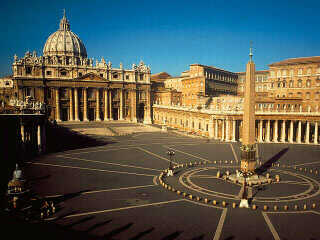
 Vatican
Vatican

During that era, European religious and government leaders made many decisions together for the city states that they were controlling. Many of these religious states were under the influence of Christianity and the Catholic religion.
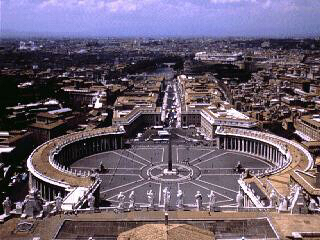 During that time, a king or a Pope was considered more powerful if they had a big and beautiful church or building to represent their powers. The bigger and more beautiful the building was the more power that king or Pope's kingdom had. Julius II wanted another church built because he was very powerful and he felt he needed to replace the old church which was 1100 years old.
During that time, a king or a Pope was considered more powerful if they had a big and beautiful church or building to represent their powers. The bigger and more beautiful the building was the more power that king or Pope's kingdom had. Julius II wanted another church built because he was very powerful and he felt he needed to replace the old church which was 1100 years old.
Julius II wanted to be known for his power so he only wanted the best artists and architects working on his church which took 150 years to complete. Some of these artists were Donate, Bramante, Giuliano, Michelangelo, Carlo Fantana, Giacomo Barozzi da Vignola, Carlo Maderno, and Giovanni. Many of the artists died during its construction, causing it to take longer. The church was built between 1443 and 1629, it took so long to build for several reasons. One, they had limited technology in the Middle Ages and it was hard to move around such huge stones by men and horses. Two, since technology of the time was very basic it took long periods of time to build structures that wouldn't take a fraction of the that time today. Three, many artists, architects and workers died during its construction. Finally, the structure chapel was not small, it is bigger than most buildings today.
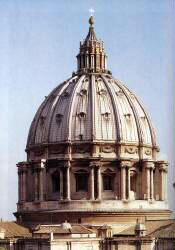 The buildings surrounding St. Peters plaza are quite large but are very small compared to this massive church. The Cathedral is 84 feet wide and 210 feet long and it stands 452 feet off the ground. There are statues of holy men and leaders all the way around the plaza and on top of the building. The plaza has 284 pillars going away from the actual church making an entrance in the front of the church. The dome which was constructed between 1588 and 1593 stands 452 feet off the ground and was designed by Michelanglo.
The buildings surrounding St. Peters plaza are quite large but are very small compared to this massive church. The Cathedral is 84 feet wide and 210 feet long and it stands 452 feet off the ground. There are statues of holy men and leaders all the way around the plaza and on top of the building. The plaza has 284 pillars going away from the actual church making an entrance in the front of the church. The dome which was constructed between 1588 and 1593 stands 452 feet off the ground and was designed by Michelanglo.
As you can see this church was built for the most powerful government and church leaders. Julius II was probably one of the most powerful men in his time and had the biggest kingdom to cover. He did not live to see the church finished
The Tomb of Julius II
Michelangelo was commissioned by Julius II to produce his tomb, which was planned to be the most magnificent of Christian times. It was to be located in the new Basilica of St. Peter's, then under construction.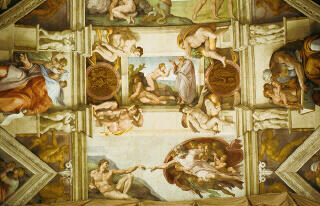 Michelangelo enthusiastically went ahead with this challenging project, which was to include more than 40 figures, spending months in the quarries to obtain the necessary Carrara marble. Due to a mounting shortage of money, however, the pope ordered him to put aside the tomb project in favor of painting the Sistine ceiling.
Michelangelo enthusiastically went ahead with this challenging project, which was to include more than 40 figures, spending months in the quarries to obtain the necessary Carrara marble. Due to a mounting shortage of money, however, the pope ordered him to put aside the tomb project in favor of painting the Sistine ceiling.
The Sistine Chapel Ceiling
Michelangelo was recalled to Rome by Pope Julius II in 1505 for two commissions. The most important one was for the frescoes of the Sistine Chapel ceiling. Working high above the chapel floor, lying on his back on scaffolding, Michelangelo painted, between 1508 and 1512, some of the finest pictorial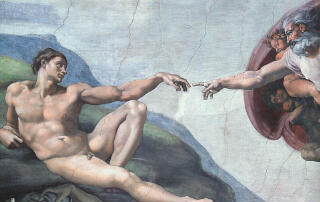 images of all time. On the vault of the papal chapel, he devised an intricate system of decoration that included nine scenes from the Book of Genesis, beginning with God Separating Light from Darkness and including the Creation of Adam, the Creation of Eve, the Temptation and Fall of Adam and Eve, and the Flood.
images of all time. On the vault of the papal chapel, he devised an intricate system of decoration that included nine scenes from the Book of Genesis, beginning with God Separating Light from Darkness and including the Creation of Adam, the Creation of Eve, the Temptation and Fall of Adam and Eve, and the Flood.
 Return to the Fridge door
Return to the Fridge door